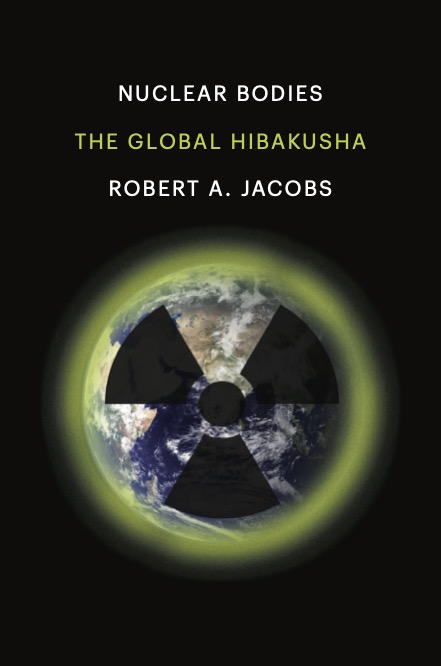New! Japanese translation has been released!
Nuclear Bodies: The Global Hibakusha
by Robert A. Jacobs
Yale University Press (2022)
In the fall of 1961, President Kennedy somberly warned Americans about deadly radioactive fallout clouds extending hundreds of miles from H‑bomb detonations, yet he approved ninety‑six US nuclear weapon tests for 1962. Cold War nuclear testing, production, and disasters like Chernobyl and Fukushima have exposed millions to dangerous radioactive particles; these millions are the global hibakusha. Many communities continue to be plagued with dire legacies and ongoing risks: sickness and early mortality, forced displacement, uncertainty and anxiety, dislocation from ancestors and traditional lifestyles, and contamination of food sources and ecosystems. Nuclear Bodies weaves these seemingly distinct legacies into a comprehensive global history, examining the colonialism(s) with which nuclear weapon states "select the irradiated," the political use of medical models to render their harm invisible, and the millennia-long legacies of our embrace of nuclear technologies.

Read the preface here:
Reviews
"Nuclear Bodies is an urgent book, a work of great ethical gravity and political import that grapples with the pernicious legacies of radiological colonialism. Jacobs unsettles conventional distinctions between war and peace, exhorting us to reimagine the Cold War as a limited nuclear war."—Rob Nixon, author of Slow Violence and the Environmentalism of the Poor
"Jacobs leaves behind the division of nuclear power into civilian and military spheres. He argues convincingly that propagandists drew this line in order to clear the way for the unhindered pursuit of nuclear weapons. In so doing, he masterfully shows how military leaders waged a limited nuclear war on the environment and human bodies."—Kate Brown, author of Manual for Survival: A Chernobyl Guide to the Future and Plutopia: Nuclear Families, Atomic Cities, and the Great Soviet and American Plutonium Disasters
"Contrary to scholarly investigations that have typically examined test site communities for the medical impacts of radioactive fallout, Jacobs offers a far more complex understanding of how radiation alters families, communities, their structures, internal dynamics, and psychology and emotions, particularly in the face of the ceaseless fear and anxiety of living in irradiated ecosystems…Among the several strengths of the book is its ability to demonstrate that nuclear events, whether the atomic bombings in Hiroshima and Nagasaki, nuclear weapons tests in 'unpeopled' sacrifice zones or nuclear power plant accidents are not inconsonant happenings. They are strung together in a continuum, entangled in a larger web of humans, nonhumans, and pasts, presents, and already implicated futures. The strength of the book is its craft of story-telling, the narration of long-winded and complex histories of nuclear technologies in simple yet profound ways." — Sonali Huria, Journal for Peace and Nuclear Disarmament
"Jacobs's comprehensive book is a useful reference for anyone looking to better understand the decades of radioactive harm inflicted on people and on the planet. His holistic view of nuclear harm, not categorized by country or by year, eliminates these artificial constraints and allows readers to fully grapple with the widespread global impact of the nuclear industry." — Alicia Sanders-Zakre, International Affairs
"Inexorable clarity and care for his fellow humans mark Robert Jacobs's guide to the Cold War as a limited nuclear war, whose harms disfigure any possible future."—Norma Field, author of In the Realm of a Dying Emperor: Japan at Century’s End
To read more about the book's contents, view short videos of the themes, full lectures on Global Hibakusha issues, or learn more about the author, continue on deeper into the website.
To order the book from Yale University Press or your preferred bookseller, use the buttons below.